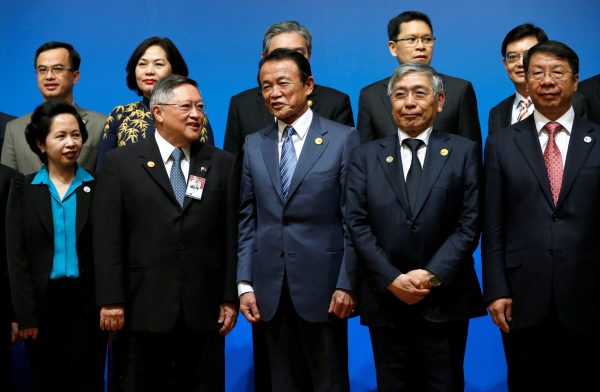The first achievement that should be noted is the actual setting up of CMIM, which was no easy task. Prior to CMIM, ASEAN+3 agreed to develop the Chiang Mai Initiative (CMI) in 2000. This was a series of bilateral swap agreements among the ASEAN founding member countries (Indonesia, Malaysia, Philippines, Singapore and Thailand) and the plus-3 countries (China, Japan and South Korea).
But when acute US dollar shortages developed during the global financial crisis, CMI played almost no role in providing liquidity to countries in the region that faced rapid capital outflows — particularly South Korea and Indonesia. Instead, South Korea received a swap of US$30 billion from the US Federal Reserve, and Indonesia received assistance from China and Japan when the United States refused a similar swap.
South Korea could have accessed up to US$16.5 billion and another US$7 billion in yen and yuan from the CMI (CMIM did not yet exist at that time). But only 20 per cent of that was available without link to an IMF supervised program, which was not politically viable for South Korea due to experiences from the Asian financial crisis.
There were also political considerations to overcome in order to set up CMIM. Negotiations about country contributions and voting power for decision making were particularly sensitive. It took almost three years after the May 2007 ASEAN+3 Finance Ministers’ Meeting in Kyoto that endorsed the multilateralisation principle for the CMIM agreement to come into effect in March 2010. After the July 2014 amendments, the total size was increased to US$240 billion and the IMF unlinked portion was set at 30 per cent of a country’s quota.
As part of the CMIM mechanism, a surveillance organisation — ASEAN+3 Macroeconomic Research Office (AMRO) — started operations in Singapore in April 2011. AMRO produces Regional Economic Monitoring Reports and Country Surveillance Reports on each of the ASEAN+3 countries and Hong Kong. A representative from each plus-3 country and three members representing ASEAN countries form the Advisory Panel and provide technical advice to AMRO on the first draft of reports. AMRO then incorporates these into final reports that are presented to AMRO’s Executive Committee made up of the ASEAN+3 finance and central bank deputies.
AMRO has added significant value to the ASEAN+3 surveillance process. Its impartial assessments have shown continual improvements in the scope of the issues and depth of the analyses. But for AMRO to be effective, it has to adopt a probing and cautionary stance, and while this should be the norm for a surveillance agency, it can lead to antagonism with the countries being surveyed.
However, currently there seems to be a general acceptance by the Excecutive Comittee that AMRO needs to maintain a slightly pessimistic view in order to provide real value-added to the surveillance process of the region. Serious debate about potential risks to various countries will be more effective for crisis prevention than if the region were to just agree that everything is under control.
Up until April 2017, AMRO has mainly operated as an in-house surveillance unit for the finance and central bank deputies. But now it is important that AMRO becomes more visible in order to build up its credibility and confidence in it as an institution, particularly given that AMRO is now an international organisation and financed by the region’s tax payers. It is good that this is precisely what is happening — for the first time, AMRO has made its 2017 ASEAN+3 Regional Economic Outlook Report publicly available.
While AMRO has made good progress, CMIM as a whole has progressed very slowly. Consider the CMIM’s crisis resolution mechanism. Thailand has a drawing quota of US$22.76 billion from CMIM. But the IMF unlinked portion is only US$6.83 billion. If Thailand needs crisis resolution again, as it did in 1997 during the Asian financial crisis, the US$6.83 billion is unlikely to be enough. Thailand would still need IMF supervision to access enough funds from CMIM and it would be subjected to IMF conditionality. So it seems there has been no progression in this regard since the Asian financial crisis.
The problem is that there seems to be no consensus among the ASEAN+3 countries about how independent the CMIM regional facility should be from the IMF global facility.
Debating whether to increase the IMF unlinked portion from 30 per cent to 40 per cent has dragged on for years and is still not resolved. Meanwhile, countries have increased self-protection by accumulating large reserves and engaging in more bilateral swap agreements with each other. Although there are political risks associated with bilateral swaps, they worked well during the global financial crisis and there are no concerns about conditionality. The 20th ASEAN+3 Finance Ministers’ and Central Bank Governors’ Meeting held on 5 May 2017 also highlighted the bilateral swap agreements within the region (amounting to about US$160 billion) in its joint statement.
Making substantive progress on CMIM so it can be a truly useful facility for the region will continue to be difficult. So it is time to rethink how the various levels of safety nets — bilateral, regional and global — should relate to each other. If most countries believe that bilateral swap agreements are most effective for them, like going back to CMI without the IMF link, then perhaps the regional and global facilities (such as CMIM and the IMF) should take a backseat from now on.
Chalongphob Sussangkarn is a Distinguished Fellow at the Thailand Development Research Institute. He was previously Thailand’s minister of finance and a member of AMRO’s Advisory Panel.

